General Motors (GM) Cruise has initiated a recall for its 950 driverless cars, with more recalls likely to come, as per a Reuters report. The recall comes after the National Highway Traffic Safety Administration (NHTSA) detected a flaw in Cruise's software.
NHTSA states that the Cruise Automated Driving Systems (ADS) software's collision detection subsystem may behave incorrectly after a collision.

Cruise likewise said that its recall, as per the Washington Post, is a move to fix the code across its whole fleet of autonomous vehicles, thereby addressing a "post-collision response" that "could increase the risk of injury."
Specifically, Cruise said that the improper "post-collision response" sees the Cruise AV pulling over out of traffic rather than staying in place in some situations, such as "when a pullover is not the desired post-collision response."
Cruise's Updated Software in Future Operations
According to the reported documents made public by the U.S. National Highway Traffic Safety Administration, test cars under the supervision of human safety drivers already have the updated software concerning the improper "post-collision response." According to the firm, the autonomous fleet will receive the updated software before resuming its operations.
Cruise states in the statement that it remains committed to continuously improving and making the recent crash reports "even rarer." Cruise also stated that "as our software continues to improve, it is likely we will file additional recalls to inform both NHTSA and the public of updates to enhance safety across our fleet."
GM's Cruise also stated it carried out the recall despite determining that, in the absence of the update, a comparable collision with a risk of serious harm may occur every 10 million to 100 million miles.
Cruise's Recent Setbacks
This move comes after numerous setbacks have plagued the company recently. In the aftermath of last month's pedestrian collision, when a person was pulled by one of Cruise's autonomous vehicles, the firm initially provided false information about the incident.
As a response, the business has already grounded its whole fleet of autonomous vehicles nationwide after the recent crash reports. At the same time, the self-driving company has also employed third-party consultants to provide more details about the company's self-driving units and recent incident responses. Cruise also appointed Louise Zhang as the company's interim chief safety officer.
On October 16, the NHTSA investigated four complaints alleging that Cruise cars would not drive cautiously enough to avoid pedestrians. It was not immediately clear whether the crash on October 2 was included in the investigation.
The reports included two injuries involving autonomous vehicles "encroaching on pedestrians present in or entering roadways, including pedestrian crosswalks in the proximity of the intended travel path of the vehicles."
With the recent setbacks, GM's stock dropped 1.6% on Wednesday to $27.95. In just the third quarter of this year, Cruise has already lost over $700 million. Just recently, GM CEO Mary Barra restated her prediction that by 2030, Cruise could bring in $50 billion in sales.
Tech Times reports that other competitors in the self-driving industry are also concerned that the problems with Cruise's autonomous operations may result in more stringent rules for all companies that produce self-driving cars.
Related Article : GM Partners with Niron Magnetics to Develop Eco-Friendly Electric Motor Magnets, Reducing Dependency on China

ⓒ 2026 TECHTIMES.com All rights reserved. Do not reproduce without permission.




